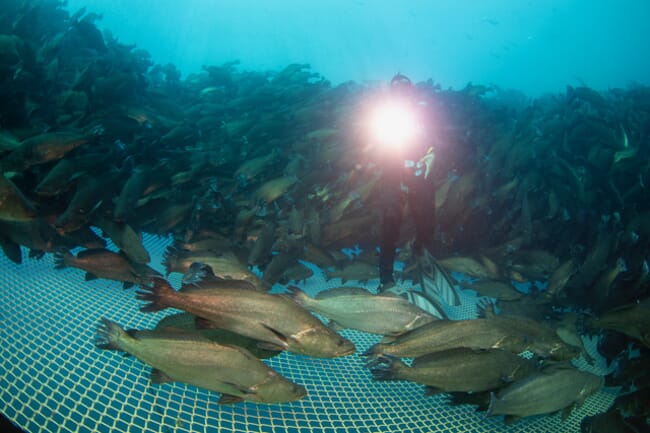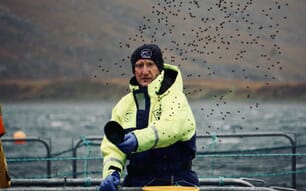
However, they are not currently allowed to export any parts of their fish, which means the black market for wild-caught totoaba swimbladders is still thriving © Earth Ocean Farms
The totoaba is a large species of fish native to the Gulf of California, which has an extraordinary value on the black market.
“Totoaba swimbladder can sell for up to $80,000 USD per kilogram in Chinese end-markets making it worth more than gold or cocaine,” marine biologist Julia Lawson, who earned her doctorate from UC Santa Barbara’s Bren School of Environmental Science & Management, explained in an article in The Current.*
This buoyancy-regulating organ is used for luxury food, expensive gifts and speculative investments in China and poaching is thriving despite an international ban on totoaba trade since 1977.
However, researchers at UCSB and AgroParisTech have now analysed market dynamics and the species’ life history to predict what might happen if farmed totoaba were legalised for export. Their results, published in Nature Partner Journals Ocean Sustainability, suggest that aquaculture may be better suited to curb poaching pressure than a strictly regulatory approach - especially if it was embraced by one of the world's most feared criminal organisations.
While better known for its narcotic trafficking activities, the Sinaloa Cartel also has a monopoly on the poaching and international trade in totoaba. Despite the complex relationship between local communities and the cartel, poaching is a way of life in many fishing villages along the Gulf of California. Because of this, the researchers say that it was relatively straightforward to get information on the fishery, the black market and aquaculture operations.
Several students travelled to Mexico to interview fishermen and farmers and they were able to estimate the operational costs of poaching – like bribes, wages, boat fuel and supplies. They also compared totoaba growth rates in captivity with rates in the wild, enabling them to estimate the time and money required to grow a fish to a competitive size.
The team combined farming and fishing costs with economic factors and the biology of the totoaba to create an analytic model of fishery and market. They pointed out that, for conservation farming to successfully reduce poaching, the latter must have a high cost of entry; farming must be competitive, ideally cheaper; customers need to view the products as being of equal value; and demand must remain relatively steady, even after legal trade is opened.
The authors also investigated how the cartel might respond to legalised totoaba aquaculture and suggested two likely scenarios. In one case, a price war could break out where the cartel tried to undercut the price of farmed totoaba by flooding the market. In this scenario, the researchers argue that the syndicate would be willing to accept short-term losses in order to push the competition out of business and regain total market share, which would not be good for wild totoaba.
On the other hand, the researchers suggest that the sellers could accept the new state of affairs and adjust the quantity of goods they sell to match their new, lower market share. This would keep prices relatively high, ensuring a healthy profit. The addition of aquaculture would mean that there’s slightly more production than in a monopoly, but a lot less than in a price war. What’s more, poaching would decrease.
"Fortunately, both scenarios shift the system into a single equilibrium, eliminating the instability currently facing the totoaba population under the monopoly," they explain.
However, they add that either case would also be a blow to the Sinaloa Cartel’s revenue stream.
“In the quantity adjustment scenario, the cartel will likely lose $192 million a year,” said co-lead author Simon Jean, an economics professor at AgroParisTech. “But in the price war, they would lose $310 million a year.”
The researchers also tried to asses what would happen if the cartel seized control of totoaba aquaculture.
“If aquaculture is taken over by the cartel, it produces even better results for totoaba than what we had first anticipated because they can leverage the whole farming operation,” Jean said, noting that the syndicate would have much less incentive to pour their resources into costly, illegal poaching if they’re operating a less expensive, legal enterprise.
Lawson and Jean see their results as a strong case for policy reform, but recognise there’s still uncertainty in how their proposal might play out.
*The full article, by UCSB's Harrison Tasoff, can be read here.




